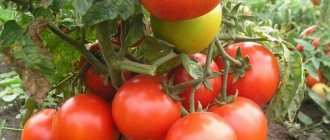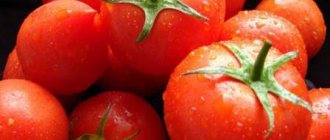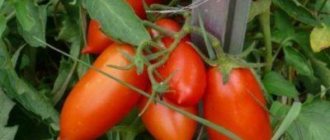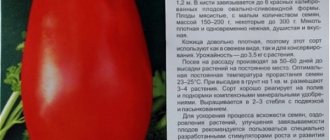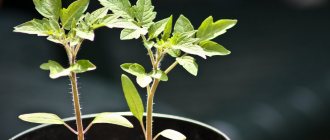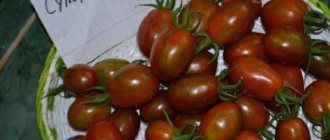Vegetable growing » Tomatoes
0
1317
Article rating
Kira Stoletova
Tomato Beefsteak is a variety of non-usual form of Moscow selection. It was bred relatively recently and entered into the official register in 2009. But even in this short period, he was able to win the hearts of many gardeners and is now grown throughout the country.
Characteristics of Beefsteak tomato variety
The main feature of the variety is not only the interesting shape of the fruit, but also its high yield. From one bush you can get up to 3.5-4 kg. tomatoes per season. In order to achieve abundant fruiting, you need to know about the characteristics of the variety and be able to provide it with good conditions for growth.
Description of the Beefsteak tomato variety
The Beefsteak tomato is an indeterminate variety that requires staking, not only the stem itself, but also each individual cluster, as this is due to its large fruit. In a greenhouse, the Beefsteak tomato reaches 2.5 m in height, in open ground it is slightly lower. The Beefsteak tomato bush is branched and grows up to 1 m wide, which should be taken into account when planting.
The leaves are simple, tomato-type. On average, 4-5 flower clusters are formed on one plant, maximum 7. The Beefsteak tomato variety is declared by the originator as a mid-early variety, but from discussions on dacha forums it is clear that this is rather a mid-season variety. From planting seedlings in a greenhouse or open ground to the start of fruiting, approximately 80-85 days pass.
Description of fruits
The Beefsteak variety is red in color when fully ripe. The shape of the fruit is flat-round, slightly ribbed. The average weight of one Beefsteak tomato is 150-250 g, but with rationing of flower clusters and a balanced diet, you can get a weight of 400 g or more.
The flesh of Beefsteak is dense, meaty, with a high content of sugars and dry matter. The Beefsteak tomato has up to 6 chambers, which contain very few seeds. The skin is thin, but strong enough to prevent cracking of ripe fruits. According to reviews, the Beefsteak tomato cannot be transported, therefore it is usually grown on private farms only for personal consumption.
Features of the plant
The variety is indeterminate, its growth stops only when you allow it to do so.
The peculiarity is that, being extremely productive, it will not be able to reach its potential if the soil nutritional value is low. Pre-planting preparation of the land, root and foliar feeding are the basis for the yield of this giant. Otherwise, you may end up with 1 - 2 large tomatoes and be disappointed.
The plant requires regular formation and timely garter. Huge fruits need to be fixed so that they cannot break the shoot, or they will collapse on their own. Formation should be carried out only in one stem, and in extreme cases, with very good soil fertility, in two stems.
Tomato "Beefsteak" description of the variety, photos, reviews indicate that the plant is medium leafy and its leaves are medium in size. The fruit stalk is articulated, but the inflorescence itself is simple. “Beefsteak” has the right to occupy a place in your garden bed, but given that it is of medium maturity, and the gardener has already tasted the first product, then, of course, there will be no special attention to this variety.
Characteristics of the variety
Tomato Beefsteak fully corresponds to the best properties of beef varieties presented on the Russian market:
- Large fruit.
- Meatiness.
- High sugar content of ripe tomatoes.
- Small amount of seeds and intracameral juice.
Productivity and fruiting
From planting seedlings in the ground to the appearance of the first ripe fruit in the cluster, 80-85 days pass. In a greenhouse, the Beefsteak variety is grown in 1 stem, in open ground (in the southern regions) - in 2. The yield per bush is approximately the same - 7-8 kg per 1 bush and it depends, to a greater extent, on skillful agricultural technology, which will be discussed speech further.
Area of application of fruits
The Beefsteak tomato is a salad tomato variety and is used mainly fresh. However, it can also be sealed for the winter in the form of juice, tomato or chopped slices in a marinade, since it is unlikely to fit entirely in a jar. Beefsteak tomatoes have proven themselves well in dried form, because their meatiness and sugar content have a positive effect on the taste of this popular, fashionable snack.
Resistance to diseases and pests
A magical variety of tomatoes, resistant to diseases and pests, has not yet been developed. And yet, according to reviews, the Beefsteak tomato variety has increased immunity to the tobacco mosaic virus, is weakly affected by cladosporiosis and is little susceptible to Alternaria leaf spot disease. If the humidity regime is not observed (more often in a greenhouse than in open ground), the Bifshtes variety, like other tomatoes, can be affected by fungal diseases: from blackleg in seedlings to late blight in fruiting bushes.
Advantages and disadvantages of the variety
In addition to its excellent taste, the Beefsteak tomato is distinguished by its relatively early ripening for large-fruited salad varieties. Resistance to a number of diseases is also an undeniable advantage.
The disadvantages of the Beefsteak tomato variety include poor transportability, which makes it unsuitable for cultivation on an industrial scale and transportation over long distances. When ripe Beefsteak tomatoes are removed from the bush, the shelf life is no more than a week.
Cultural information
The Beefsteak tomato variety was bred through breeding and seed production. These seeds are also sold by other well-known companies: Sibsad, Aelita. Beefsteak is recommended for growing under greenhouse cover, but it also feels great outdoors in the southern regions of Russia.
Beefsteak tomatoes are widely used in cooking. They are used fresh and for making tomato juice. They are also suitable for preparing various dishes, especially sandwiches and pizza. They are also good for winter preparations, but for this you need to cut the fruits into slices, since tomatoes are large in size.
Tomato steak
Beefsteak tomatoes have a wonderful, slightly sweet taste. They contain significantly more pulp than juice and seeds. This variety of tomatoes is valued by vegetable growers for its high content of vitamins and other beneficial substances.
There is also a tomato variety called Big White Beefsteak. Its ripe fruits have an unusual milky-white color with a slight pinkish tint, unusual for this crop. In terms of taste characteristics and parameters, the white variety is practically no different from the red one.
Characteristics and features of the variety
Tomato Beefsteak characteristics and description of the variety:
- The plant is an indeterminate variety, that is, it is not limited in growth. The height of the bush can be incredible, so it is adjusted mechanically. Vegetable growers recommend removing the top at a height of 2 m;
- The leaves of the plant are medium in size and green;
- The bush is strong, growing up to 1 meter wide. Because of this feature, there is a need to plant bushes sparsely. Otherwise, they will not have enough area to form large fruits;
- The formation of bushes occurs from 1 or 2 stems, and in white specimens - from 2 or 3 stems;
- The brush is simple; usually about 5 tomatoes ripen on it. The fruits will be much larger if 2-3 ovaries are left on the cluster and the rest are removed;
- The fruits are bright red or milky in color, depending on the variety;
- Shape – flat-round with small ribs;
- The average weight of one fruit is 300 grams. If you follow the recommendations for agricultural cultivation and care, the weight of tomatoes can be significantly greater;
- The skin of the fruit is thin, so they are not stored for more than a week and do not tolerate transportation;
- The number of seed chambers is 6, the content of seeds in them is small;
- Beefsteak is a mid-early tomato variety. However, summer residents believe that this variety ripens as mid-season. The first harvest can be obtained after 80-85 days from planting the seedlings;
- Productivity is about 8 kg per 1 sq. meters.
Having familiarized yourself with the properties of the Beefsteak tomato, it is worth adding to the description of the variety that the plant is highly resistant to some diseases. Tomatoes are practically free from tobacco mosaic, cladosporiosis and alternaria blight. However, the crop is sensitive to late blight and gray rot, so when growing the Beefsteak variety, preventive measures should be taken against these diseases.
Growing rules
It is impossible to achieve the manifestation of the best qualities of a particular variety without following the rules of its agricultural technology. The taste of tomatoes, their productivity, and resistance to diseases and pests depend on proper care, which begins with sowing the seeds.
Planting seedlings
Good Beefsteak tomato seedlings start with high-quality seeds and properly selected (or composed) soil. Compliance with the variety can only be guaranteed by trusted producers of planting material - reputable agricultural companies with a reputation. However, recently, tomato seeds from private hobbyists have been in increased demand. The description of the Beefsteak tomato given in this article will help identify misgrading by its appearance. All tomato seeds need to be pre-treated with a strong manganese solution before sowing in the ground, except for pelleted ones - they are sown dry.
Any universal soil for seedlings is suitable for tomatoes. The main thing is that it is breathable and loose due to the content of vermiculite or perlite. If you have a large number of seedlings, you can “dilute” the purchased soil mixture with garden soil. But it must be sifted and disinfected by heating it in the microwave or freezing it on the balcony or in the yard.
For 5 parts of store-bought soil, take 1.5-2 parts of soil from the garden. It would not be amiss to add 1 part of sand or vermiculite to such a composition.
Tomatoes are sown in containers of different sizes - from individual plastic cups to wooden boxes lined with oilcloth. Recycled containers must be washed with hot water and disinfected with a dark pink solution of potassium permanganate. When sowing in boxes, space on shelves or window sills is significantly saved, while individual pots take up an prohibitively large amount of free space. Therefore, the choice of container depends on the volume of seedlings being grown and the availability of space for it.
Sowing seeds
After dressing, the tomato seeds are either dried and sown directly into the ground, or first germinated in a damp cloth. With the second method, it is very convenient to determine the germination of tomato seeds: if they do not germinate on the 5th day, then they are discarded. Tomato seedlings grown from them are unlikely to be of high quality and will not bring a good harvest.
Dry or pecked tomato seeds are planted to a depth of 1-1.5 cm in pre-moistened soil. When sowing in boxes or other large containers, the distance between rows is 4-5 cm, and between seeds in a row at least 2 cm. If planted more closely together, the tomatoes will shade each other and stretch out.
2-3 seeds are planted in individual containers in order to subsequently remove the weakest of the sprouts. After sowing tomatoes and before the emergence of seedlings, greenhouse conditions must be created in seedling containers: high humidity and air temperature of at least + 20 °C. Lighting becomes an important factor after green loops appear en masse on the soil surface.
Important! In the first 4-5 days, seedlings need round-the-clock illumination.
This is a guarantee that the tomatoes will not stretch out and will be strong and stocky. Indeed, these days, the sprouts take everything they need for the development of the root system and above-ground parts, not from the soil, but solely through the process of photosynthesis.
Picking
When the first pair of true leaves appears, tomatoes growing in boxes need picking. It can be placed in the same boxes, but at a greater distance, or in individual containers of the appropriate size. The soil for replanting is used the same as when sowing tomatoes, but up to 1 tbsp is added to it. l. complete mineral fertilizer per volume of 5 liters.
Important! The main rule when growing tomato seedlings is that the leaves of neighboring plants should not overlap.
When picking tomatoes, it is permissible to cut or tear off the main root by 1/3 and bury the seedling in the ground almost level with the cotyledon leaves. These techniques stimulate better development of the tomato root system. If the time for planting in the ground is delayed for some reason, the tomatoes may need a second picking.
Seedling care
Light, warmth, water and fertilizing are what are necessary for the normal growth and development of tomatoes. Lighting of seedlings should be uniform throughout the day and amount to 10-12 hours a day, which means that artificial additional illumination of growing tomatoes is necessary. The optimal distance from the light source to the top of a growing tomato is 10-15 cm.
The difference between day and night temperatures for tomatoes can be 4-5 degrees. During the day – + 22-24 °C, at night – + 18-20 °C. A temperature drop to + 10 °C can pose a threat to the existence of tomato seedlings.
Tomatoes do not like excessive watering, so drying the soil until the leaves slightly wilt is acceptable. Not only excess moisture contributes to the appearance of root rot, but also too cold water. Tomatoes can be watered only with warm, settled water; they do not need spraying.
The first feeding of young tomatoes can be done no earlier than 10 days after the picking. To do this, use ready-made mineral complexes or make your own composition: 5 g of urea or ammonium nitrate, 30 g of superphosphate, 15 g of potassium sulfate per 10 liters of water. After 2 weeks, fertilizing the seedlings should be repeated.
Transfer
Tomatoes are transplanted to a permanent place at the age of 55-60 days. At this point, the tomato plant should have a thick (1 cm in diameter) trunk, 7-9 leaves and 1 flower cluster. Overgrown tomato seedlings are planted in the ground “lying down”, that is, laying them sideways in a prepared furrow, deepening them to the first lower leaves. No more than 3 plants are placed on an area of 1 m²; the planting pattern for the Beefsteak variety is 60x40 cm. Planting dates depend on the region and location (greenhouse or greenhouse). In the photo there is a Beefsteak tomato bush; according to reviews from summer residents, its height before planting in the ground is usually about 30 cm.
Aftercare
When planting a Beefsteak tomato in the ground, water it abundantly and immediately after that mulch with any available material - cut grass, straw, humus or sawdust. This technique will allow you to regulate uniform moisture and temperature conditions. The soil in the root zone of tomatoes should be constantly moist, but not wet. Infrequent watering of tomatoes is permissible only if the seeds are planted directly in the soil and with high-quality mulching.
The Beefsteak tomato is an indette variety, so it definitely needs support in the form of a trellis or pegs for garter. The bush is most often formed into 1 stem, removing stepsons as they appear. With good care, the Beefsteak tomato forms up to 7 flower clusters, each producing 4-5 fruits. To get large tomatoes, some of the ovaries must be removed at an early stage.
More information about the correct formation of a tomato bush is described in the video:
A bountiful harvest of Beefsteak tomatoes cannot be obtained without adequate nutrition of the bushes; for this it is necessary to ensure soil fertility by adding organic matter or mineral fertilizers. Organic matter is usually added to the beds in the fall; in addition, when planting in a hole, add 1-2 handfuls of humus or compost and 1 tbsp. wood ash.
During the season, slurry and green fertilizer - a fermented infusion of grass - are used, but only before fruit formation begins. Next, it is necessary to increase the proportion of potassium supplements - ash extract, potassium sulfate solution or potassium monophosphate. It is better for beginning gardeners to use ready-made mineral fertilizer complexes depending on the stage of development of tomatoes.
Important! To reduce the risk of blossom end rot in tomatoes, preventive fertilizing with calcium nitrate is introduced twice a day with an interval of 2 weeks.
This is done at the fruiting stage.
Features of agricultural technology
To successfully grow Beef tomatoes, you need to know some nuances. When planting per square meter of area, two or three plants are sufficient. Good feeding is required. The Beef tomato needs to be shaped so that it only has one stem left. There are many inflorescences, they are pinched. Usually up to five ovaries are left. If the weight of the fruit is two hundred and fifty grams or more, then three is enough. The fruits will grow uniform, the plant will receive balanced generative and vegetative development.
During the flowering of the third cluster, the first two need to be thinned out before the flowers bloom. This should be done at least once a week. After the first ovaries appear, one or two lower leaves are removed. This is necessary to prevent plants from diseases. Affected leaves are removed as soon as they are noticed. By the time the first fruits of the first cluster begin to ripen, not a single lower leaf should remain on the plant. Large, fleshy hybrids have different ripening periods, plant height, color and weight of fruits, but their excellent taste remains unchanged.
Pest and disease control
The Beefsteak tomato variety is resistant to a number of diseases, however, with excessive humidity, especially in cold summers, the bushes may be at risk of late blight. There is no radical cure for this terrible nightshade disease, but preventive measures will help reduce the risk of its occurrence:
- When planting tomatoes, add biological preparations Glyokladin, Alirin or their analogues to each hole.
- Systematic watering of plants with Fitosporin solution.
- Spraying tomato bushes with folk remedies: diluted water, serum with iodine or a solution of the pharmaceutical product Trichopolum (20 tablets per 1 bucket of water).
At the first signs of late blight, you need to remove suspicious leaves and treat the tomatoes with any available chemical: from ordinary copper sulfate to elite Previkur. In case of severe damage, diseased bushes must be removed from the area and burned. Preventive measures against late blight are also effective against other diseases caused by spore-bearing fungi.
The most common pests of tomatoes are: whitefly, spider mites, aphids, Colorado potato beetles and root-knot nematodes. When they appear, supporters of folk remedies usually turn to their favorite methods: infusions of wormwood, garlic, hot pepper, tobacco, celandine, etc.
Chemical preparations are selected based on the presence of a specific pest: acaricides - against ticks and bedbugs, insecticides - against the vast majority of insects, hand collection and traps - against beetles and their larvae, mole crickets.


